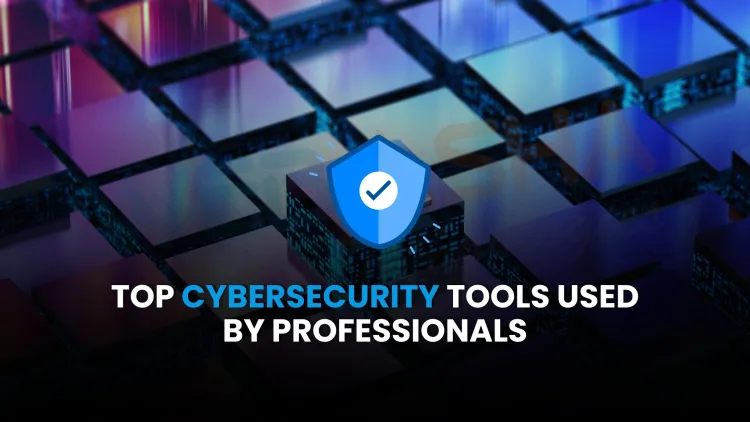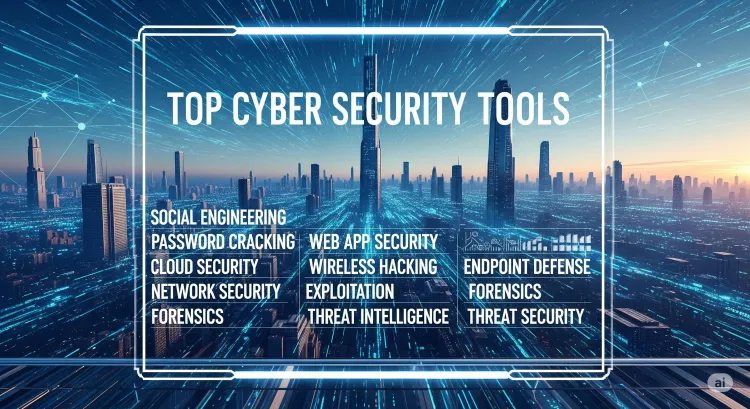What are the top cybersecurity tools used by professionals in 2025?
Cybersecurity professionals in 2025 rely on a wide range of specialized tools to detect threats, secure networks, and investigate breaches. From password cracking and web application testing to forensics and threat intelligence, each tool plays a critical role in maintaining digital security. Popular tools like Wireshark, Metasploit, Burp Suite, and Nmap continue to dominate their respective categories. This blog provides a comprehensive breakdown of the top cybersecurity tools across 12 essential domains including social engineering, cloud security, endpoint protection, and more.

Table of Contents
- What Are Cybersecurity Tools?
- Complete List of Top Cybersecurity Tools by Category
- Breakdown of Each Category and Tools
- Why These Tools Matter in Today’s Cyber Landscape
- How to Choose the Right Tool
- Conclusion
- Frequently Asked Questions (FAQs)
Cybersecurity is no longer a luxury—it's a necessity. With the rise in cyber threats, vulnerabilities, and sophisticated attacks, organizations and individuals must equip themselves with the right tools to protect systems, networks, and data. In this blog, we explore the top cybersecurity tools of 2025, categorized by their specific use cases—from social engineering to threat intelligence and beyond.
Let’s dive deep into the most essential cybersecurity tools you should know about today.
What Are Cybersecurity Tools?
Cybersecurity tools are specialized software or platforms designed to help protect digital assets by identifying, preventing, detecting, and responding to threats. These tools vary widely in function and are often categorized by the specific cybersecurity domain they support, such as forensics, endpoint protection, penetration testing, and vulnerability management.

Complete List of Top Cybersecurity Tools by Category
Below is a structured table that outlines the leading cybersecurity tools in each domain:
| Category | Top Tools |
|---|---|
| Social Engineering | GoPhish, HiddenEye, SocialFish, EvilURL, Evilginx, SET (Social Engineering Toolkit) |
| Password Cracking | Hashcat, John the Ripper, Hydra, Medusa, Cain & Abel, Ophcrack |
| Web App Assessment | OWASP ZAP, Burp Suite, Nikto, WPScan, Acunetix, Arachni |
| Cloud Security | AWS GuardDuty, Azure Security Center, Google Cloud Security Command Center, Prisma Cloud, Lacework, Wiz |
| Wireless Hacking | Aircrack-NG, Wifite, Kismet, TCPDump, Reaver, Wireshark |
| Exploitation | Metasploit, Burp Suite, SQLMap, ExploitDB, Core Impact, Cobalt Strike, Empire |
| Vulnerability Scanning | Nessus, OpenVAS, Nexpose, Qualys, Acunetix, Lynis |
| Forensics | Wireshark, Autopsy, Volatility, SleuthKit, Binwalk, Foremost, EnCase |
| Network Defense | Snort, Suricata, pfSense, Security Onion, AlienVault OSSIM |
| Endpoint Security | CrowdStrike Falcon, SentinelOne, Carbon Black, Symantec Endpoint Protection, Microsoft Defender for Endpoint |
| Threat Intelligence | ThreatConnect, Recorded Future, AlienVault OTX, IBM X-Force Exchange, MISP |
| Information Gathering | Nmap, Shodan, Maltego, TheHarvester, Recon-NG, Amass, Censys, OSINT Framework, Gobuster, Spiderfoot |
Breakdown of Each Category and Tools
Social Engineering Tools
Social engineering attacks manipulate human psychology. These tools simulate such attacks for training or testing defenses.
-
GoPhish: Phishing simulation framework.
-
HiddenEye: Advanced phishing tool for red teaming.
-
SET: Popular toolkit for social engineering attacks and payloads.
Password Cracking Tools
Used during penetration testing or recovery, these tools test password strength.
-
Hashcat: GPU-accelerated password cracker.
-
John the Ripper: Open-source and customizable.
Web Application Security Testing
These tools scan for vulnerabilities like XSS, SQLi, and broken auth.
-
OWASP ZAP & Burp Suite: Industry favorites for dynamic application testing.
Cloud Security Tools
These platforms provide visibility and control across cloud environments.
-
AWS GuardDuty & Azure Security Center: Built-in tools for cloud-native security monitoring.
Wireless Hacking Tools
They analyze and penetrate Wi-Fi networks.
-
Aircrack-NG: Cracks WEP/WPA keys using capture files.
-
Wireshark: Packet analyzer that’s useful for wireless and wired traffic.
Exploitation Frameworks
Used for offensive security, vulnerability testing, and post-exploitation.
-
Metasploit: The most recognized framework in ethical hacking.
-
Cobalt Strike: Advanced threat emulation.
Vulnerability Scanning Tools
These scan systems for weaknesses that can be exploited.
-
Nessus & OpenVAS: Commonly used enterprise scanners.
-
Acunetix: Focused on web vulnerabilities.
Forensic Tools
They help in post-incident analysis by analyzing data artifacts and memory.
-
Autopsy: Graphical front-end for The Sleuth Kit.
-
Volatility: Memory forensics framework.
Network Defense Tools
Tools used to detect, analyze, and respond to network-based attacks.
-
Snort & Suricata: Network intrusion detection and prevention systems.
-
pfSense: Open-source firewall and router.
Endpoint Security Tools
These tools protect endpoints like PCs, laptops, and servers.
-
CrowdStrike Falcon: AI-powered threat detection and response.
-
Microsoft Defender: Built-in enterprise-grade protection.
Threat Intelligence Tools
They collect, analyze, and act on cyber threat data.
-
AlienVault OTX & Recorded Future: Real-time threat feeds and intel dashboards.
Information Gathering Tools
Useful for reconnaissance in ethical hacking or red team ops.
-
Nmap: Scans ports and services.
-
Shodan: Search engine for connected devices.
-
Maltego: Visual link analysis for relationships and open-source intelligence.
Why These Tools Matter in Today’s Cyber Landscape
With threats ranging from ransomware and phishing to advanced persistent threats (APTs), using these tools offers:
-
Proactive threat identification
-
Better compliance with regulations (e.g., GDPR, HIPAA)
-
Improved incident response
-
Cost-effective vulnerability management
How to Choose the Right Tool
-
Define Your Objective: Are you testing, defending, or investigating?
-
Evaluate the Environment: Cloud vs. On-premises? Enterprise vs. SMB?
-
Tool Reputation: Open-source vs. commercial? Community support?
-
Scalability & Integration: Does it integrate with your SIEM or SOC?
Conclusion
The cybersecurity battlefield is constantly evolving. Staying updated with the latest and most effective tools can make the difference between a breach and a secure infrastructure. Whether you are a penetration tester, a SOC analyst, or a cybersecurity student, the tools listed above provide a robust foundation to secure and test modern digital environments.
FAQs
What are the most used cybersecurity tools in 2025?
The most commonly used tools include Nmap for scanning, Metasploit for exploitation, Burp Suite for web testing, Wireshark for network analysis, and CrowdStrike Falcon for endpoint security.
Which tool is best for penetration testing?
Metasploit Framework is widely regarded as the most powerful tool for penetration testing due to its vast library of exploits and payloads.
Is Wireshark only used for hacking?
No, Wireshark is primarily used for legitimate network monitoring, troubleshooting, and protocol analysis by IT and cybersecurity professionals.
What tools help in password cracking?
Tools like Hashcat, John the Ripper, Hydra, and Cain & Abel are popular for testing password strength through brute-force and dictionary attacks.
Which tool is recommended for web application assessment?
OWASP ZAP and Burp Suite are top tools for identifying security flaws in web applications, including XSS and SQL injection vulnerabilities.
How does Nmap help in cybersecurity?
Nmap is a network scanner that helps identify open ports, running services, and network vulnerabilities—crucial for reconnaissance.
Are cloud security tools different from traditional tools?
Yes, tools like AWS GuardDuty and Google Cloud Security Command Center are tailored specifically for cloud infrastructure security.
What is the Social Engineering Toolkit (SET)?
SET is an open-source Python tool designed to simulate advanced social engineering attacks like phishing and credential harvesting.
Which tools are useful for mobile hacking?
Tools like HiddenEye and Evilginx are often used for phishing simulations and social engineering attacks on mobile platforms.
Can forensic tools be used legally?
Yes, forensic tools like Autopsy and EnCase are widely used by law enforcement and corporate investigators for digital evidence collection.
What is the purpose of vulnerability scanning tools?
Tools like Nessus and OpenVAS identify and report vulnerabilities within systems and networks before attackers exploit them.
Is Burp Suite free?
Yes, Burp Suite offers a free Community Edition with basic features, while the Professional Edition includes advanced capabilities.
Which tool is best for OSINT?
TheHarvester and Maltego are widely used for open-source intelligence gathering and passive reconnaissance.
How do threat intelligence tools help?
They provide actionable insights into emerging threats, helping organizations proactively defend against cyber attacks.
What is the use of Snort in network security?
Snort is a signature-based Intrusion Detection System (IDS) that monitors network traffic and detects malicious activities.
Is Metasploit legal to use?
Yes, it’s legal when used in authorized penetration testing or cybersecurity training environments.
How does pfSense help with network defense?
pfSense is an open-source firewall/router that provides network segmentation, intrusion prevention, and VPN support.
Which tool is best for wireless hacking?
Aircrack-NG is widely used for cracking Wi-Fi passwords and analyzing wireless traffic.
What is the role of Autopsy in digital forensics?
Autopsy helps in recovering deleted files, analyzing disk images, and uncovering digital evidence during investigations.
Are there tools to monitor cloud environments?
Yes, tools like Azure Security Center and Prisma Cloud offer robust monitoring and threat detection for cloud-based systems.
Which cybersecurity tools are open-source?
Many tools like Nmap, Wireshark, Metasploit, OpenVAS, and Aircrack-NG are open-source and widely adopted in the industry.
What is Shodan used for?
Shodan is a search engine for internet-connected devices and can be used to discover exposed systems or IoT vulnerabilities.
How can I use Gobuster?
Gobuster is used to brute-force directories, DNS subdomains, and files on web servers during reconnaissance.
What tools are used for endpoint protection?
Popular tools include CrowdStrike Falcon, SentinelOne, Symantec Endpoint Protection, and Microsoft Defender.
What is the difference between IDS and IPS?
IDS (Intrusion Detection System) detects threats, while IPS (Intrusion Prevention System) actively blocks them. Snort and Suricata can be configured for both.
What is MISP used for?
MISP is a threat intelligence platform that facilitates sharing of Indicators of Compromise (IOCs) between organizations.
Which tool helps detect advanced persistent threats?
Cobalt Strike is often used in Red Team operations to simulate APT-style attacks and test an organization’s resilience.
Can non-tech people use these tools?
Some tools like GoPhish and SET have user-friendly interfaces, but many others require technical knowledge to operate effectively.
How does Google Cloud Security Command Center work?
It offers centralized visibility into assets and threats in GCP, helping detect misconfigurations and policy violations.
Which tool is best for malware analysis?
Volatility is excellent for memory forensics and malware investigation in volatile memory (RAM) dumps.














![Top 10 Ethical Hackers in the World [2025]](https://www.webasha.com/blog/uploads/images/202408/image_100x75_66c2f983c207b.webp)








